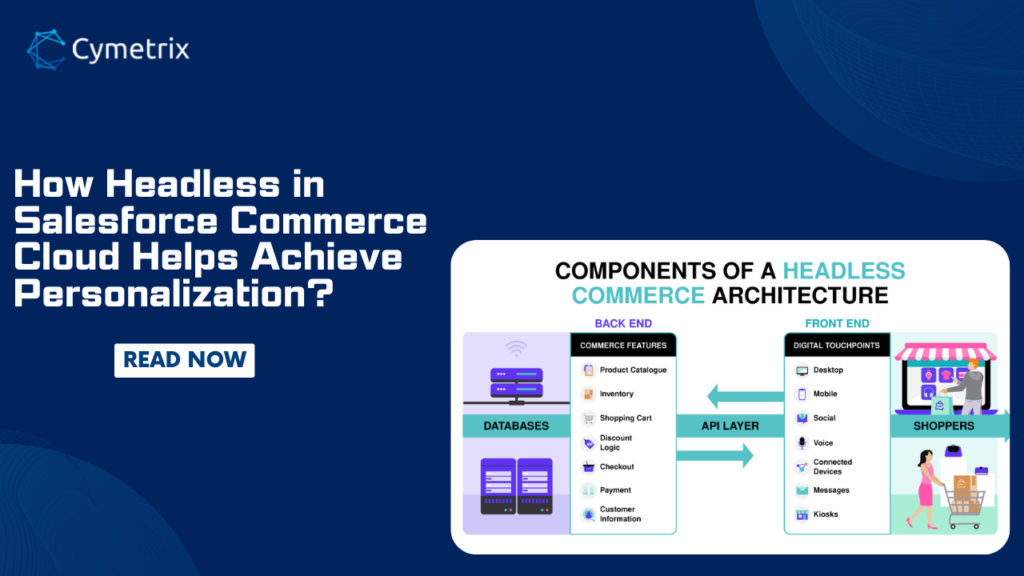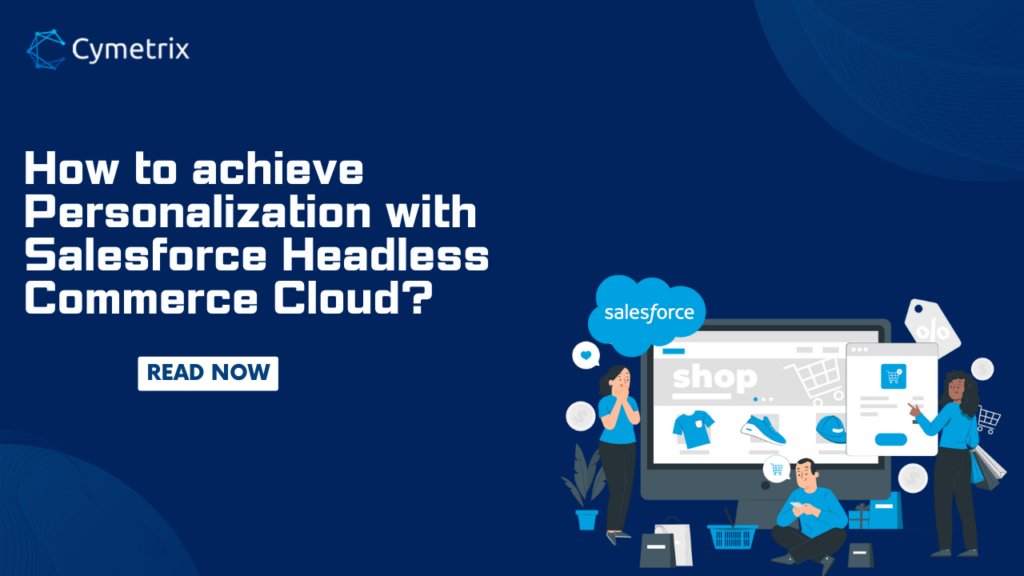
Learn how the headless Salesforce Commerce Cloud enables seamless personalization, offering tailored user experiences across devices. Enhance customer engagement and boost conversions!
Are you tired of generic shopping experiences that leave your customers feeling disconnected from your products? Do you yearn to offer a more personalized online shopping journey tailored for each customer? If so, you’re not alone! In today’s fast-paced e-commerce world, customer experience is the cornerstone of success, and achieving true personalization is the key. In this blog, we will explore the game-changing concept of Salesforce Headless and how it empowers businesses to create unforgettable shopping experiences that speak directly to each customer’s unique tastes and preferences.
The Commerce Cloud implementation team at Cymetrix Software, one of the leading global Salesforce Consulting Partners, will share insights to help you understand how to use headless Salesforce Commerce Cloud to achieve personalization.
But before that, let us understand the benefits of personalization in e-commerce, which by the way is more than just product recommendations and email marketing.
What Are the Benefits of Personalization in E-commerce?
E-commerce personalization has emerged as a game-changer for businesses, revolutionizing the way they engage with customers and deliver shopping experiences. By tailoring content, recommendations, and promotions based on individual preferences and behavior, personalization enhances the overall customer experience.
Let’s explore some of the key advantages of incorporating personalization into e-commerce strategies:
- E-commerce businesses can use personalization to align products and services with customer expectations, leading to higher customer satisfaction.
- It can help an E-commerce optimize its product displays, pricing, and promotions, as per customer needs, which leads to higher sales and conversion rates.
- You can use personalization for your E-commerce to build long-lasting relationships with customers by delivering personalized loyalty rewards, exclusive offers, and follow-up communications.
- By understanding the reasons behind cart abandonment and leveraging personalized retargeting strategies, businesses can entice customers to return and complete their purchases, reducing cart abandonment rates.
A Note on Personalization in Salesforce
The Salesforce platform is renowned for its robust personalization capabilities, empowering businesses to deliver exceptional customer experiences at every touchpoint. With advanced features and tools, Salesforce can help you tailor interactions, communications, and recommendations based on individual customer preferences and behavior.
Customer 360 View
At the heart of Salesforce’s personalization capabilities is the Customer 360 view, a comprehensive and unified profile of each customer. This view consolidates data from various touchpoints and channels. With a holistic view of each customer, you can gain valuable insights to personalize interactions and deliver relevant content.
Data Cloud
Salesforce’s Data Cloud is a robust platform that enhances personalization capabilities by providing access to vast amounts of external data. By leveraging the Data Cloud, businesses can enrich their Customer 360 profiles with additional demographic and behavioral data. This information can help you gain deeper insights into their customers, identify new opportunities, and deliver even more personalized and targeted experiences.
Journey Builder for Personalization
Salesforce’s Journey Builder can help you create personalized customer journeys by designing automated workflows based on specific triggers and customer actions. With Journey Builder, you can deliver personalized content and offers at each stage of the customer journey, ensuring that customers receive the right message at the right time.
Marketing Cloud Personalization
Salesforce Marketing Cloud offers advanced personalization features that allow you to deliver tailored email campaigns, dynamic content, and personalized web experiences. With segmentation and dynamic content capabilities, you can customize marketing communications to meet the unique needs and interests of each customer segment.
Commerce Cloud Personalization
Salesforce Commerce Cloud provides robust personalization capabilities for e-commerce businesses. It can help you leverage customer data and behavior to offer personalized product recommendations, targeted promotions, and dynamic pricing to create a tailored shopping experience for each customer.
Einstein AI for Personalization
Salesforce Einstein, the AI-powered technology within the Salesforce platform, is essential in personalization. By leveraging machine learning algorithms, Einstein analyzes massive customer data to predict preferences, behaviors, and product affinity. This predictive intelligence enables you to offer proactive and highly personalized customer experiences.

How to achieve Personalization with Salesforce Headless Commerce Cloud?
Before we start let’s take a quick glimpse and understand What is Headless Ecommerce.
It simply refers to the separation of the front and back end of an Ecommerce website. In contrast to traditional Ecommerce where the front and back end are tightly integrated.
Now, you must be aware that Personalization has become a fundamental aspect of e-commerce, as customers increasingly expect tailored experiences that cater to their unique preferences and needs. Let’s explore how SFCC Headless helps achieve personalization and deliver exceptional customer experiences.
Leveraging AI and Machine Learning
Salesforce Commerce Cloud integrates advanced AI and machine learning capabilities to analyze vast customer data, identify patterns and trends, and deliver highly personalized experiences. Furthermore, AI-powered recommendation engines can suggest relevant products, while machine learning algorithms can continuously optimize personalization strategies based on customer behavior and preferences.
Harnessing the Power of APIs
APIs play a pivotal role in headless commerce. Commerce Cloud provides seamless APIs that expose e-commerce functionalities, including product catalogs, inventory management, and promotions. These APIs empower businesses to integrate with third-party systems, such as marketing automation, CRM, and analytics tools. Therefore, leveraging APIs allows you to access and utilize customer data to personalize the shopping experience at various touchpoints.
Leveraging Microservices Architecture
Headless Salesforce Commerce Cloud embraces a microservices architecture, which breaks down e-commerce functionalities into minor, independent services. So, each service handles a specific task or capability, enabling businesses to adopt a modular approach to development. This flexibility allows for easier customization, scalability, and the implementation of personalized features and experiences.
Delivering Targeted and Personalized Content
You can also deliver targeted and personalized content to your customers using Salesforce Headless. As a result, you can create highly relevant product recommendations, individualized offers, and tailored content that resonate with individual customers, by analyzing customer data and behavior. This level of personalization enhances the overall customer experience, boosts engagement, and increases the likelihood of conversions.
Enhancing Omnichannel Experiences
Nowadays, customers engage with businesses through various channels, including websites, mobile apps, social media platforms, and more. Headless in Salesforce Commerce Cloud enables you to provide a consistent and seamless experience across these channels. Thus, with the ability to integrate multiple touchpoints, you can deliver personalized content and promotions.
Embracing Real-Time Personalization
Lastly, you can use Salesforce Headless Commerce to seamlessly integrate inventory management systems, and ensure real-time visibility of product availability. That enables you to provide accurate information to customers, prevent out-of-stock situations, and offer personalized alerts when products are back in stock.
Implementing Salesforce Headless Commerce Cloud
So, by implementing Salesforce Commerce Cloud headless, you can unlock flexibility, scalability, and customization in your e-commerce endeavors. Let’s explore the key steps and best practices for implementing headless commerce in Salesforce Commerce Cloud.
Define Clear Objectives and Requirements
Before diving into the implementation process, you should define clear objectives and requirements. Thus, you need to understand your business goals, target audience, and the specific personalization features you want to achieve through this process.
Plan the Architecture and Design
Furthermore, we suggest you determine how the front-end and back-end systems will interact via APIs. So, consider utilizing a microservices architecture, which allows for modular development and scalability.
Develop and Customize the Front-end Experience
With headless commerce salesforce, businesses can develop and customize the front-end experience independently from the back-end. You can leverage modern technologies, frameworks, and design principles to create user-friendly and engaging interfaces.
Integrate Third-Party Systems
Salesforce Commerce Cloud offers APIs and integration capabilities that enable businesses to connect with marketing automation tools, CRM, payment gateways, and more. So, you will have to integrate these systems to leverage customer data, personalize experiences, and streamline operations.
Ensure Security and Compliance
Implementing Headless Salesforce Commerce Cloud requires a strong focus on security and compliance. So, you should regularly perform security audits and stay updated with industry standards and regulations to maintain a safe and trustworthy e-commerce environment.
Test and Optimize
Thorough testing is crucial to ensure the quality and functionality of the Salesforce Headless implementation. You should conduct comprehensive testing, including functional testing and performance testing, to identify and address any issues or bugs to provide a seamless and error-free user experience.
Provide Ongoing Support and Maintenance
Once the Salesforce Commerce Cloud headless implementation is live, it’s essential to provide ongoing support and maintenance. You need to monitor the performance, and security and stay updated with the latest updates and releases.
Conclusion
In conclusion, implementing Salesforce Headless opens up endless possibilities for businesses looking to accomplish unparalleled personalization in their e-commerce endeavors.
As businesses embrace the era of personalization, it’s crucial to partner with a trusted solution provider like Cymetrix. Unlock the full potential of headless commerce in Salesforce Commerce Cloud with Cymetrix Software. Contact us today to get in touch with our team.
